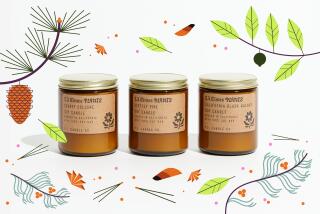In the Wick of Time
- Share via
In yet another modern-day irony in this increasingly high-tech world, candles--those ancient light-givers--are now one of the hottest items on the market.
Stores are relegating major space to them, and candle boutiques, such as the new Illuminations in South Coast Plaza in Costa Mesa, are popping up almost as quickly as Starbucks franchises. Some estimates put annual candle sales in the U.S. at $1 billion.
Thus, this scenario: Employees working at computers with cups of lattes and lemon-scented candles burning nearby become the modern equivalent of Bob Cratchit working by the light of a single candle in Dickens’ “A Christmas Carol.”
And why not? Candles are relatively inexpensive and can act as potpourri, mood lighting and decoration.
“Candlelight is beautiful, romantic, celebratory, and it creates movement,” says Wally Arnold of Illuminations.
To better highlight candles’ luminosity, Arnold had dim chiaroscuro lighting installed “so you can experience the magic of candlelight by having both light and shadows. We want this store to be like an oasis.”
Candles were painted on prehistoric caves, and candlesticks were found that date back as far as 2500 BC in Egypt and Crete. Historian Pliny tells of candles in the first century that were made either of pitch with a wick of flax or of molten wax in which a rush was dipped and the wax allowed to harden.
*
In her book “Naturally Creative Candles” (1997, Quintet Publishing, $19.95), Letty Oates writes: “In Mediterranean countries, candles were made from oil and because the olive oil did not rise far up the wick, they were shaped flat like slippers.” In Northern Europe, she writes, “where no natural oil was available, the poor used ‘farthin dips’ or ‘rushlights’ made by dipping thin rush stems in tallow [animal fat] or beeswax.”
When stearin was found to harden animal fats, it was used to create an inexpensive candle that didn’t produce black smoke as tallow candles had.
“Joseph Morgan invented a candle-making machine in 1834. This machine was capable of manufacturing 1,500 candles an hour. Two years later, a palm oil substance was patented as an alternative to waxes,” Oates writes.
For Arnold, owner of Illuminations, the idea for a candle store was inspired by friends living abroad. “They lived part of their day by candlelight, and there is a quality of life that that brings. In Sweden it would be unusual at any time of the year not to have a candle burning on the table.
“I wanted this store to show people how to integrate a little candlelight into their lives. Everyone is living at such a fast pace that we saw that as the answer to the Internet,” Arnold says.
Part of Arnold’s mission is to educate customers about candles.
“Candles are usually made from either paraffin wax or beeswax,” he says. “Paraffin is a byproduct of refining petroleum. In the state the oil companies sell it, it has a lot of oil left in it, sometimes up to 5%. Our candles are refined beyond food grade, which means they could be put around Gouda cheese. Theoretically they’re edible. That allows for a smoke-free burn, an oil-free burn.”
The first time you burn a pillar candle, let the pool of wax extend to the outside of the candle. The rule of thumb is one hour for every inch in diameter. Large candles can take up to three hours.
“If you light a candle and let it burn 20 minutes and then blow it out, you’ll end up with a pool of wax the size of a quarter. That creates a memory, and it will burn right down the center of the candle. Then you’ll get a flame inside the tunnel of wax and it will put itself out,” Arnold says. “A quality candle not burned in a draft will never drip.”
For even, long-burning candles, use unbleached cotton wicks. When you relight a candle, trim the wick to one-quarter-inch in length.
Don’t use scented candles that compete with food aromas, but there are candles that absorb the scents of smoke or cooked onions.
Decor experts are tweaking the creative use of candles. Gone is the pair of plain white tapers centered on the dining room table around a vase of flowers. Instead, candles and candlesticks can be different sizes, shapes and colors.
Float them atop glass marbles in a silver bowl full of water, or slice oranges in a water-filled glass and put a candle on top.
More to Read
The biggest entertainment stories
Get our big stories about Hollywood, film, television, music, arts, culture and more right in your inbox as soon as they publish.
You may occasionally receive promotional content from the Los Angeles Times.










